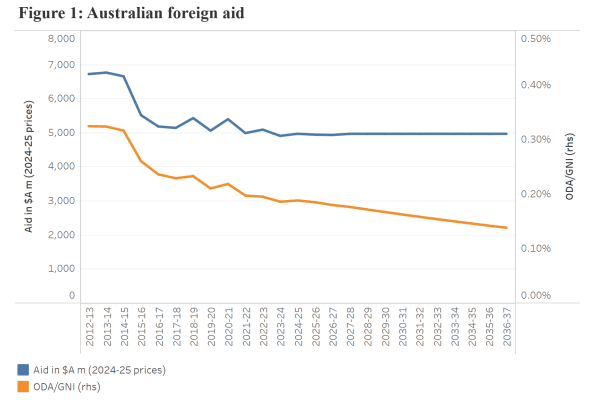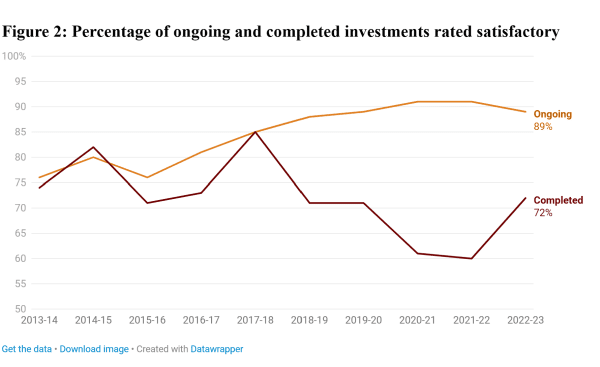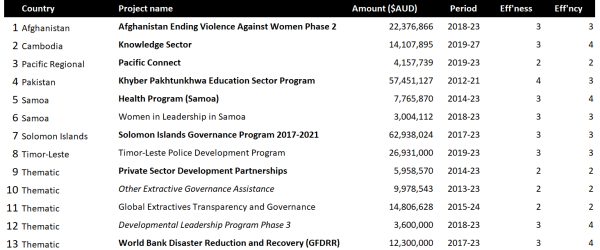
[ad_1]
Overseas support was elevated by 4% over what had been projected final 12 months to deliver the 2024-25 support price range to $4.961 billion, nearly unchanged from the (inflation-adjusted) 2023-24 stage of $4.900 billion.
The small enhance this 12 months is sustained into the long run. Actually, after this 12 months, support is projected to remain virtually precisely unchanged for the subsequent decade and past. Over the ahead estimates and past, the help/GNI ratio is projected to proceed to fall, from the present 0.19% to as little as 0.14% by 2035-36. It is vitally laborious to see in these figures the help “rebuild” that Labor claims to have launched into.

Most nation allocations are unchanged, however there are a couple of winners. The share of support to the Pacific continues its inexorable rise, reaching 44% on this price range, up from 42% in 2023-24 and simply 23% a decade earlier. Tuvalu’s support allocation will increase from $17 million in 2023-24 to $87 million in 2024-25 to help implementation of the Australia-Tuvalu treaty. ($87 million can also be the quantity of Australian support budgeted for the entire of sub-Saharan Africa in 2023-24.) Fiji will get a further $35 million for price range help and a port enlargement. Indonesia will get an additional $27 million for a local weather and vitality initiative. There’s additionally $65 million in new funding to help current commitments to the Inexperienced Local weather Fund and the Pacific Resilience Facility.
The largest shock is in sectoral allocations. Nearly 1 / 4 of the help program went to well being in the course of the pandemic, and just under 20% within the final two years. However well being spending is slashed on this price range to only 13% of complete support. That’s the second lowest it has been within the final decade, and never what you’ll anticipate from a Labor authorities, particularly not one popping out of a pandemic. Nevertheless, this authorities has made clear its dedication to governance and infrastructure, and the shares of each enhance on this price range. Schooling and humanitarian spending are in some way protected, leaving well being weak, because it was underneath the Coalition previous to the pandemic.
Whereas there’s little else to report from the 2024-25 support price range, there have been main modifications during the last 12 months in the way in which through which Australian support effectiveness is conceived of and measured.
Australia’s new worldwide growth coverage was launched in August final 12 months. It promised new nation methods, in addition to new methods on gender, incapacity and humanitarian support. About 9 months on, none of those has been revealed. However the first annual report on the “Efficiency of Australian Improvement Cooperation 2022-23” has been.
Up till 2020, the Australian support program measured support effectiveness by trying on the proportion of investments that had been rated as passable yearly. Managers rated their very own applications, and more and more thought they had been doing effectively. This indicator saved on enhancing, reaching 90% or extra.
In 2020, a wise choice was made: to guage support effectiveness solely by reference to the evaluation of accomplished investments, assessments nonetheless made by DFAT, however a minimum of not by the implementing supervisor. These assessments, being extra unbiased, had been extra dependable, however additionally they gave a lot much less spectacular outcomes, and ones that worsened over time.
In 2023, within the new coverage, DFAT determined to hedge its bets and say that it might report each outcomes. The issue with this method is that it lays naked the massive disconnect between ongoing and accomplished assessments that we highlighted in our report final 12 months. For DFAT itself, this isn’t a bug however a function: the finished investments are, it says, judged by a better commonplace. The issue with this argument is that the disconnect solely begins in 2019 – exactly when these accomplished funding scores had been taken out of the fingers of undertaking managers.
Though the disconnect seems to go down in 2022-23, actually evaluation reveals that that is primarily because of the truth that the investments that got here to an finish final 12 months had been usually of above-average high quality. The precise hole between the final score an funding is given by its supervisor and the score it’s given by exterior consultants on closing has solely fallen barely.
The desk beneath reveals the issue on the particular person funding stage. These are the 13 investments rated in 2022-23 as unsatisfactory at completion. Solely three of them had been rated unsatisfactory after they had their final managerial or ongoing evaluation. Two of them didn’t have such an evaluation, and for eight of them, a verdict of passable whereas ongoing was, on completion, downgraded to certainly one of unsatisfactory.
Desk 1: Unsatisfactory support investments, 2022-23 analysis interval
Be aware: Daring signifies the funding went from passable in its final ongoing score to unsatisfactory in its remaining score. Plain signifies no change in standing from passable to unsatisfactory or vice versa. Italics means no score within the earlier 12 months. The effectiveness and effectivity scores are out of 5 (with 3 or much less unsatisfactory). Supply: DFAT efficiency information.
DFAT clearly must get an earlier deal with on which investments aren’t working effectively, in order that it faces fewer surprises when investments are closed, by which era it’s too late to right non-performance. Till the disconnect is decreased, efficiency ought to be judged with regards to accomplished, not ongoing, investments.
Domestically-led growth is a significant precedence for the brand new support coverage, so it’s no shock that the not too long ago launched efficiency report additionally has a piece on it, with 5 indicators. Sadly, there is no such thing as a point out of price range help, which is the obvious and essential method through which the Australian support program helps locally-led growth. Finances help is 2022-23 was 9.3% of the entire support price range, the very best it has been for a minimum of a decade.
There’s as a substitute a powerful concentrate on the hiring of nationwide employees by managing contractors, who, we’re informed, employed 3,842 native employees and contractors in 2022-23, a rise of 15%. The advantages of hiring nationwide employees are apparent. (As Lead Economist for the World Financial institution in India, I benefited from heading a terrific crew of Indian economists.) But it surely’s not locally-led growth. Certainly, in fragile states and small international locations, hiring nationwide employees generally is a type of de-localisation, sucking expertise out of native authorities, non-government organisations and personal firms to work for donors at a lot larger salaries. As these two lecturers put it, donors can “subvert administrative capability” when their “presence is massive and expert labour is extraordinarily scarce.”
Knowledge introduced within the efficiency report indicate that the common wage for a nationwide employees member is $37,740, which is 9 occasions the PNG minimal wage. Does the Australian support program have a wage coverage to make sure that, the place it’s a massive donor, it isn’t distorting native labour markets, and thereby undermining localisation?
Different localisation indicators introduced are extra helpful. Managing contractors cross on about 20% of the funding they obtain to native organisations. Australian NGOs cross on little or no of the event funding they obtain, however 36% of their DFAT Australian Humanitarian Partnership funding. Including these quantities collectively provides about $290 million, solely two-thirds of the worth of price range help in 2022-23.
A higher concentrate on funding native organisations – together with governments – and a lesser one on hiring nationwide employees is required to push the localisation agenda ahead.
Devpol’s Australian Assist Tracker has been up to date with the brand new price range numbers.
[ad_2]
Supply hyperlink
